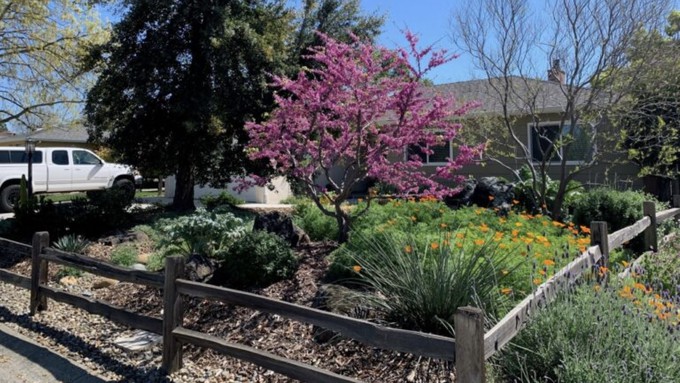
How one Sacramento family turned their front lawn into much more

The Salisbury family's front yard has plenty of colorful plants and no lawn. Courtesy Lance Salisbury
Lance Salisbury considers himself an “early adopter” of water-wise gardening. The Sacramento homeowner ditched his front lawn almost 10 years ago.
“I moved into my current house 11 years ago and it had a big grassy front yard with trees and shrubs,” Salisbury says. “The backyard was even more grass. After tackling that lawn, I was tired of mowing before I even got to the front yard. It was the most grass I ever mowed in my life.”
Salisbury grew up in southern Nevada; he knew there was another way.
“We always had water conservation,” says Salisbury, an environmental scientist for California’s Department of Fish and Wildlife. “My dad was a (water-wise) adopter before anything but grass was considered an option.”

At his own Arden Arcade home, Salisbury kept the backyard lawn. “I have young kids; they play in the backyard. But I wanted the front yard to resemble nature. That was my inspiration.”
Helping Salisbury complete his makeover was a $850 rebate from the Sacramento Suburban Water District, his water provider.
“I went to board hearings and made a spiel about why they should adopt a ‘Cash for Grass’ program. There are tons of water wasted and, like me, people are tired of mowing.”
That was April 2015; SSWD adopted the program and Salisbury was among the first in line. “I think I was in the first five people who got it. I was going to do it regardless. The rebate paid for about a third of the total project. I did all the work myself.”
The former lawn was transformed into a water-wise landscape featuring redbud and desert willow trees plus sages and loads of poppies. The makeover saves water year round plus a swale captures roof run-off during storms. “Hundreds of gallons soak into the ground, not go out into the street,” he says.
“I did a lot of research at the UC Davis Arboretum,” says Salisbury, noting UCD’s water-wise gardens. “You need plants that can handle freezing temperatures and rain in winter, and then the heat of summer.”
Salisbury’s front yard now attracts an abundance of wildlife including bumblebees, lizards and even wild turkeys, he says. That’s just what he wanted. “I created my own little wildlife sanctuary.”
For his efforts and results, the Salisbury family was among the Regional Water Authority’s “Summer Strong Yard Champs.” This summer, they appeared on local billboards to provide inspiration to other Sacramento homeowners.
To learn more including how to get rebates for your water-wise projects, go to: https://bewatersmart.info/.
Comments
0 comments have been posted.Sacramento Digs Gardening to your inbox.
Food in My Back Yard Series
April 1: Don't be fooled by these garden myths
March 25: Fertilizer tips: How to 'feed' your vegetables for healthy growth
March 18: Time to give vegetable seedlings some more space
March 11: Ways to win the fight against weeds
March 4: Potatoes from the garden
Feb. 25: Plant a fruit tree now -- for later
Feb. 18: How to squeeze more food into less space
Feb. 11: When to plant? Consider staggering your transplants
Feb. 4: Starting in seed starting
Sites We Like
Garden Checklist for week of March 30
Your garden doesn’t mind April showers. Get busy now to enjoy those future flowers.
* Get ready to swing into action in the vegetable garden. As nights warm up over 50 degrees, start setting out tomato, pepper and eggplant transplants.
* From seed, plant beans, beets, cantaloupes, carrots, corn, cucumbers, melons, pumpkins, radishes and squash. (Soak beet seeds overnight in water for better germination,)
* Plant onion sets.
* In the flower garden, plant seeds for asters, cosmos, celosia, marigolds, salvia, sunflowers and zinnias.
* Transplant petunias, zinnias, geraniums and other summer bloomers.
* Plant perennials and dahlia tubers for summer bloom.
* Transplant lettuce and cabbage seedlings.
* April is the last chance to plant citrus trees such as dwarf orange, lemon and kumquat. These trees also look good in landscaping and provide fresh fruit in winter.
* Smell orange blossoms? Feed citrus trees with a low dose of balanced fertilizer (such as 10-10-10) during bloom to help set fruit. Keep an eye out for ants.
* Apply slow-release fertilizer to the lawn.